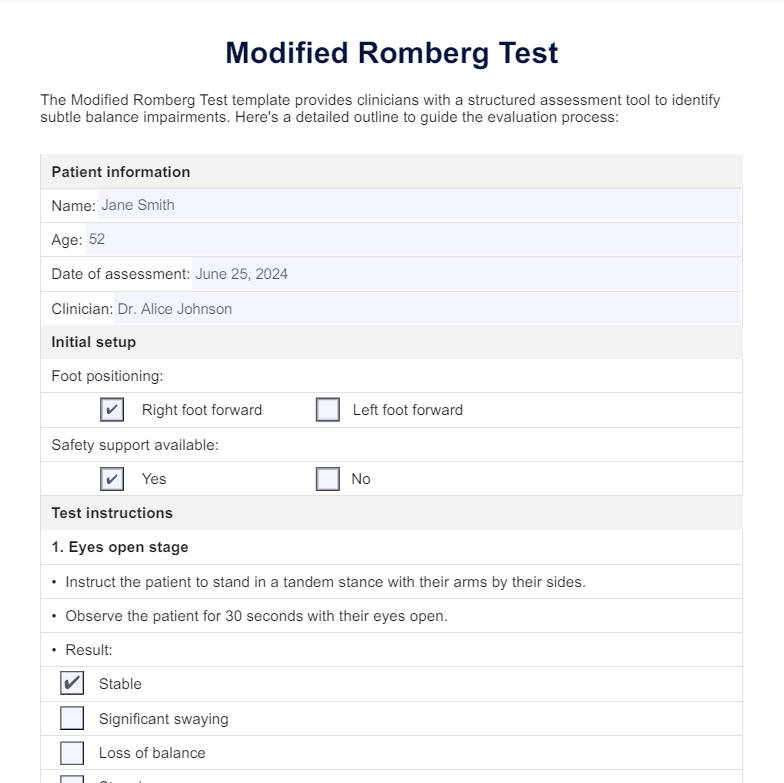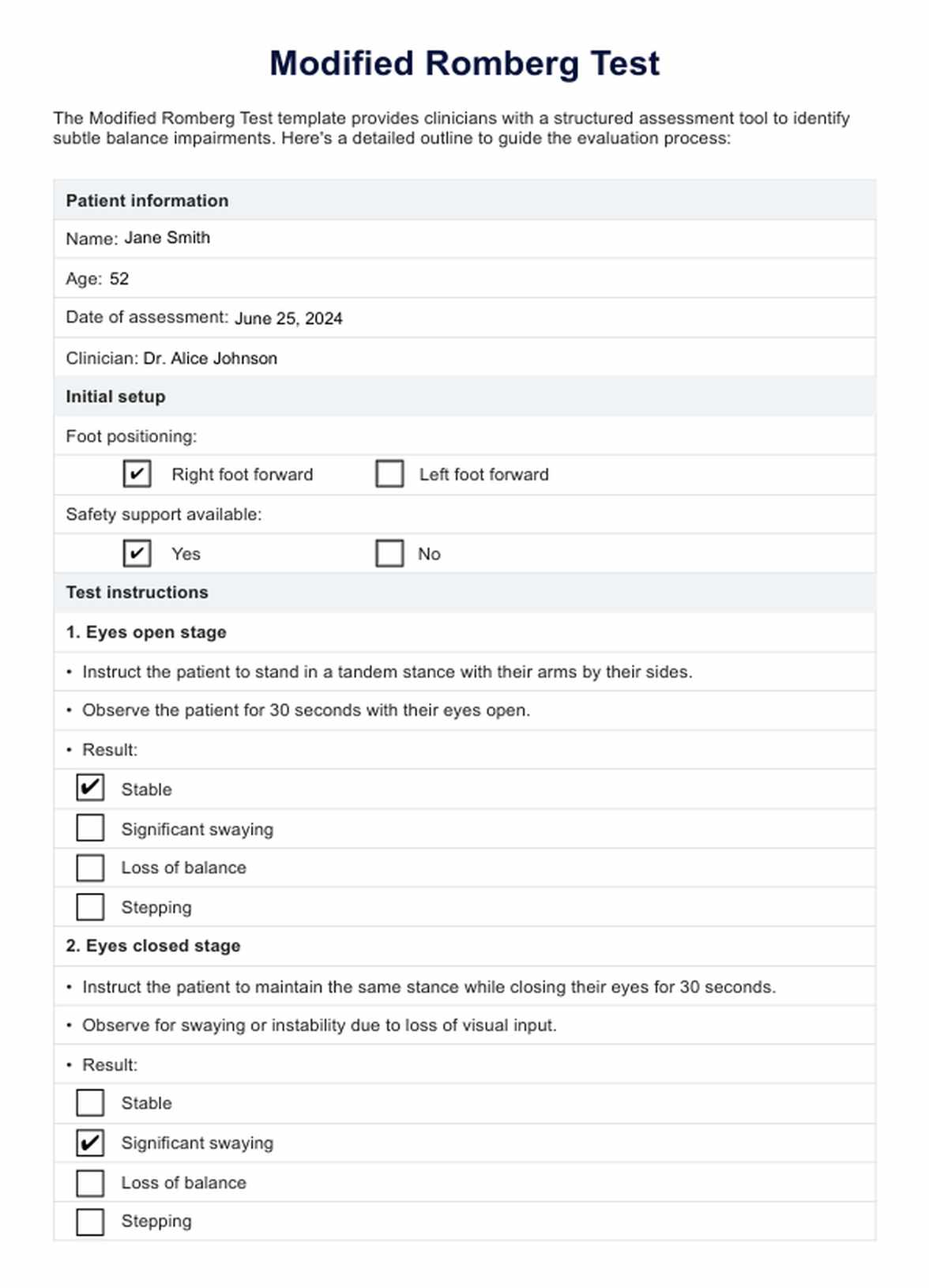Modified Romberg Test
Learn how the Modified Romberg Test helps diagnose lumbar spine stenosis and balance issues. Download our template for a comprehensive assessment and accurate results.


What is lumbar spine stenosis?
Lumbar spine stenosis refers to the narrowing of the spinal canal in the lower back. This condition can compress the nerves and spinal cord and cause pain, numbness, or weakness. It often results from age-related changes in the spine, such as arthritis, herniated discs, or thickened ligaments.
Symptoms of lumbar spine stenosis
These are the symptoms of lumbar spine stenosis:
- Pain or cramping in the lower back or legs
- Numbness or tingling in the legs or feet
- Muscle weakness that affects mobility
- Reduced endurance for walking or standing
Causes of lumbar spine stenosis
Here are the causes of lumbar spine stenosis:
- Age-related degeneration leading to bone overgrowth
- Herniated discs pressing on nerves
- Thickening of spinal ligaments
- Congenital spinal deformities
Modified Romberg Test Template
Modified Romberg Test Example
What is the Modified Romberg Test?
The Modified Romberg Test is a balanced assessment that helps detect vestibular and proprioceptive disorders by assessing the patient's ability to maintain balance under different conditions.
While the traditional Romberg Test uses a simple stance with feet together, the modified version tests balance by having the patient stand with one foot directly in front of the other (tandem stance), further challenging the vestibular system.
How is this conducted?
The Modified Romberg Test helps healthcare professionals better evaluate the integrity of the vestibular system, proprioception, and the neurological pathways responsible for maintaining balance.
The Modified Romberg Test provides a comprehensive sensory and vestibular function evaluation by assessing the patient’s ability to maintain balance with both eyes open and closed.
Initial setup
- Positioning: Have the patient stand in a tandem stance, with one foot placed directly in front of the other (heel to toe). This setup places additional demand on the vestibular system, making it easier to detect subtle balance issues.
- Safety precautions: Ensure the patient is in a safe environment, preferably close to a wall or stable structure they can hold onto if needed. A healthcare provider should stand nearby to offer support if the balance is lost.
Conducting the test
- Eyes open stage: Instruct the patient to keep their arms relaxed by their sides and to maintain balance in the tandem stance with their eyes open for 30 seconds. This stage assesses the patient’s ability to maintain balance using all available visual, proprioceptive, and vestibular cues.
- Eyes closed stage: Have the patient close their eyes while maintaining the tandem stance for another 30 seconds. The absence of visual input increases the reliance on the proprioceptive and vestibular systems for balance, making this stage a more challenging assessment.
Monitor for indicators
- Observe the patient for significant swaying, loss of balance, or an inability to hold the stance.
- A positive Romberg Test may include symptoms like swaying, frequent use of external support, or a stepping response to catch balance. These signs may indicate potential sensory pathway impairment or issues with the vestibular system that need further evaluation.
By following these steps, clinicians can effectively conduct the Modified Romberg Test to identify possible balance impairments, providing crucial information to guide further neurological assessments and treatment.
How to interpret the results
The Modified Romberg Test provides essential information to guide diagnosis and treatment, helping healthcare professionals create targeted intervention plans for patients experiencing balance-related concerns.
Positive test
A positive result indicates that the patient cannot maintain balance during the test, particularly with their eyes closed, or exhibits significant swaying, stepping to stabilize, or a complete loss of balance. Such findings suggest a potential sensory or vestibular dysfunction. It indicates issues with proprioception, the vestibular system, or the sensory pathways responsible for maintaining balance. This result warrants further investigation to identify the underlying cause and may point toward conditions like vestibular disorders, sensory neuropathy, or other neurological issues.
Negative test
A negative result signifies that the patient can maintain balance without significant swaying or needing external support. They should be able to hold the tandem stance for 30 seconds with their eyes closed and open, demonstrating stable balance and intact vestibular function. This outcome indicates a normal response to the physical test, suggesting no significant abnormalities in the sensory, vestibular, or proprioceptive systems that control balance.
By differentiating between positive and negative results in the Modified Romberg Test, clinicians can gain valuable insights into a patient's neurological and sensory health, guiding further assessment or treatment planning.
Benefits of conducting this test
Conducting the free Modified Romberg Test offers several key advantages in assessing and diagnosing balance disorders:
Comprehensive vestibular and proprioceptive assessment
The test effectively evaluates the visual and vestibular components and proprioceptive systems by requiring the patient to maintain balance in a tandem stance, both with eyes open and closed. This reveals deficits in balance crucial for identifying underlying conditions affecting sensory or vestibular function.
Differentiates between visual and non-visual balance components
By performing the test with the patient's eyes open and then closed, clinicians can determine how much the patient relies on visual cues to maintain balance. The eyes-closed stage eliminates visual compensation, uncovering non-visual balance impairments related to the vestibular system or proprioception.
Identifies neurological conditions affecting balance
The test is particularly effective in identifying signs of neurological conditions such as vestibular disorders, sensory neuropathy, and lumbar spine stenosis. A positive Romberg Test, where the patient loses balance or exhibits significant swaying, suggests vestibular dysfunction or issues with proprioceptive sensory pathways.
Facilitates accurate diagnosis and treatment planning
The test provides detailed insights that support the diagnosis of balance impairments and guide treatment plans. Clinicians can tailor their interventions to address the specific sensory or vestibular deficits impacting the patient’s balance.
Overall, the Modified Romberg Test is a valuable tool for healthcare professionals conducting balance assessments, enabling a more accurate and nuanced understanding of balance impairments and their underlying causes.
Commonly asked questions
Treatments like physical therapy, pain management, and lifestyle changes can significantly alleviate symptoms.
It can detect vestibular and proprioceptive issues, which are common symptoms of this condition.
The recovery time depends on the severity of the condition and the type of treatment pursued. Non-surgical treatments like physical therapy may improve within a few weeks to several months. However, if surgery is necessary, recovery can take up to six months or longer, depending on the procedure.

.jpg)





































































































